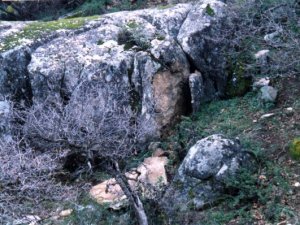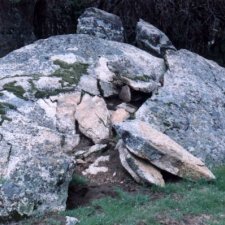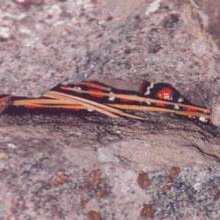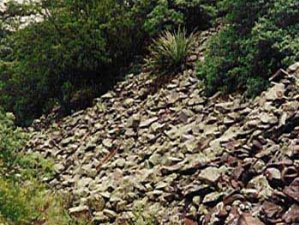
Center of Controversy: Rock Damage
Rock damage. It's a phrase that disheartens every naturalist. And the more one witnesses it, the more the frustration grows. Why? Because of its unaesthetic qualities? Because of the irritating notion that a single ignorant person can, within the span of a few minutes, wreck a microenvironment forged by the timeless forces of nature? Because the people at fault suffer from the disillusionment that nature serves solely as a source for them to exploit, simply that because it exists it can be taken and destroyed? Perhaps such reasons help explain why fellow enthusiasts and wildlife agencies will not tolerate such actions.
But the real heart of the matter lies in the fact that destroying natural rock formations does not benefit the collector, the seasoned field observer, the captive breeder, or even the novice hobbyist. For the collector, damaging or removing flakes, exfoliations, leaners, and cap rocks essentially ensures that mountain kingsnakes can never again be caught at those points. And the demolished formations left behind cast a bad light on everyone involved in this hobby. Resulting legislation propelled by concern over habitat degradation not only hinders mountain kingsnake specialists, but it also effects the entire trade. DAMAGING ROCK STRUCTURES SERVES NO ENDS. THUS IT MUST BE CONSIDERED A GREAT WASTE OF A VALUABLE RESOURCE. Utimately, no one gains from rock destruction--not even the collector who turns up the occasional animal in the process.
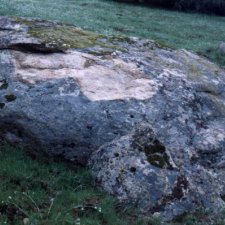 |
|
Many claim that these unique formations only account for a small part of the microhabitat utilized by mountain kingsnakes, that the absence of these features due to destruction does not affect the ability of these animals to survive, and that these structures primarily serve as a convenient way for people to locate these secretive snakes. These convictions may very well be true. HOWEVER, CONTINUED ABUSE WILL RESULT IN GOVERNMENTAL REGULATION REGARDLESS OF THE HEALTH OF THE SNAKE POPULATIONS IN QUESTION. Enthusiasts must understand this key concept if they wish to advance their avocation.
In fact, the regulating has already begun; if collectors refuse to change their course of conduct, the statutes will become more and more severe. Prompted by the increasing amount of havoc wreaked by overzealous zonata hunters, the California Department of Fish and Game moved to protect L. zonata primarily in hopes of preventing further destruction of the state's natural environment. Historically, collectors have failed to curb their own scrupulous behavior. Now, all hobbyists must pay the price: no one may legally take or possess San Diego mountain kingsnakes (L. z. pulchra) or any zonata from San Diego County, Orange County, or from Los Angeles County west of I-5, even though evidence demonstrates that zonata populations in those areas have maintained viable population levels . The matter has not been taken lightly; the United States Department of Fish and Wildlife Service recently decided to investigate a proposal to list zonata as threatened under the Convention on International Trade of Endangered Species.
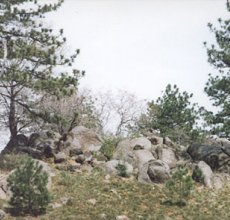 |
| |
| Properly caring for the microhabitat will make future trips to a specific locality more enjoyable. Not only can one harvest additional mountain kingsnakes from the same exact rocks, but the observations gained from that unspoiled area give considerable insights into the behavioral patterns of the animals living there. Images: above; well managed habitat, showing a specimen of zonata taking advantage of natural shelter that has been left intact. Photos by Dave Long. | ||
Not all collectors lack morals, but society has taken notice only of the ones that do. Responsible enthusiasts become like phantoms of the field; they leave no traces of their activity. They return all rocks to their original positions. And they do not force cracks or fissures open. They know that a mountain kingsnake which has retreated into the security of rock fracture should rightfully be left to its peace; they know better that to split granite boulders with a crowbar. They know they cannot remove every specimen they encounter in the wild, so they do not fret if they observe a snake they cannot reach. They know all this because they have confidence in their skills to uncover mountain kingsnakes without having to resort to ransacking the environment. Ultimately, they know they have a duty to uphold the quality of the natural world.
| It takes much more work to tear apart the talus and gravel-rock piles that L. pyromelana prefers. The commotion caused by such laborious efforts quicky drives pyromelana deep within the intersititial spacing, thus preventing capture. As a result, Arizona has less of a problem with rock damage than California. Image: right; undisturbed stream-side talus. Photo by Kirk Setser. |
|
All things having been said, the issues at hand address the sentiments reflected in the simple, but cogent terms of Leopold: "Conservation is a protest against destructive land use. It seeks to preserve both the utility and beauty of the landscape."
